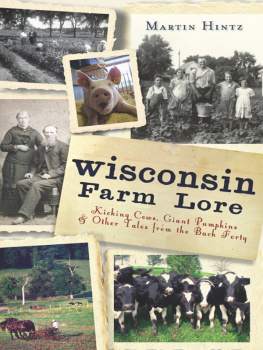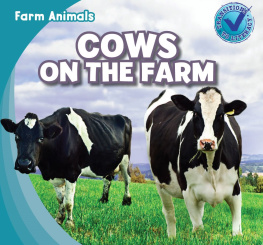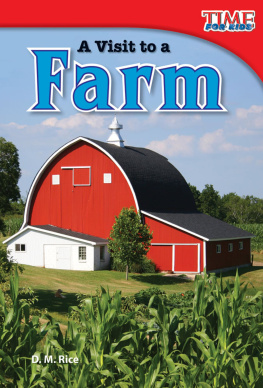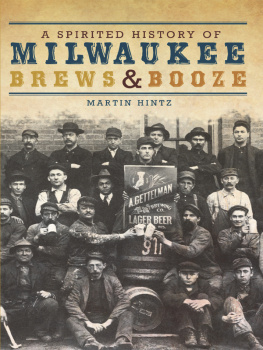
Published by The History Press
Charleston, SC 29403
www.historypress.net
Copyright 2012 by Martin Hintz
All rights reserved
First published 2012
e-book edition 2012
ISBN 978.1.61423.573.6
print ISBN 978.1.60949.538.1
Library of Congress CIP data applied for.
Notice: The information in this book is true and complete to the best of our knowledge. It is offered without guarantee on the part of the author or The History Press. The author and The History Press disclaim all liability in connection with the use of this book.
All rights reserved. No part of this book may be reproduced or transmitted in any form whatsoever without prior written permission from the publisher except in the case of brief quotations embodied in critical articles and reviews.
To all the ancestors who were farmers. And to the next generation.
Contents
Acknowledgements
The author wishes to thank the many folks who provided assistance on this book, including farmers, stock breeders, librarians, authors, educators, marketers, agricultural association representatives, federal/state/county professionals, scientists and farm organizations. Their help was invaluable. Special thanks also to my wife and farming partner, Pam Percy.
The Land
No other human occupation opens so wide a field for the profitable and agreeable combination of labor with cultivated thought, as agriculture.
Abraham Lincoln
WISCONSINS TOPOGRAPHY
Wisconsin is noted for its natural beauty and rich resources. Shaping of the landscape is attributed to the hard, grinding work of glaciers thousands of years ago:
For preparing Wisconsin to be the abode of a great civilizationglacial action was significant in several ways. It tended to iron out the rougher, hilly surfaces; it made the flat lands more rolling by creating elevations of glacier-bone materials upon them; it made soil and distributed it over vast areasfor the purposes of agriculture, it was almost as fortunate that the flat lands were made more uneven as that the rough lands were made more smooth. A gently rolling surface affords natural drainage, for the want of which much flat land becomes waste in unfavorable seasons. Besides, the glacial hills and hillocksthe moraines, drumlines, kames, and eskers (to borrow the geologists terms)diversify the surface, vary the tree growth, and account for much of the natural beauty for which Wisconsin is so justly famed.
JUNEAU OPENS TRACTS FOR SETTLEMENT
Noted Wisconsin entrepreneur Solomon Juneau bought up several tracts of land around what was then Washington City. He parceled them out to eager settlers who were starting to flood into Wisconsin from the East and overseas. Their plows slowly tamed the earth, forcing Chief Waubeka and the last of the Potawatomi nation from the area in 1845. One land section of Juneaus holdings eventually became part of the original Afterglow Farm acreage, owned by the Uihlein family. A copy of a Juneau deed remains in the their archives.
Certificate No. 469
The United States of America
To all to whom these presents shall come, Greeting:
Whereas, a Certificate of the Register of the Land Office at Milwaukee, Wisconsin, has been deposited in the General Land Office, whereby it appears that full payment has been made by the claimant Solomon Juneau according to provisions of the Act of Congress of April 24, 1820, entitled An Act making further provision for the sale of public lands, and the acts supplemental thereto, for the northeast fractional quarter of Section Two in Township eleven north of Range twenty-two east of the Fourth Principal Meridian, Wisconsin, containing one hundred fortyfour acres and twenty-eight hundredths of an acre, according to the Official Plat of the Survey of the said Land, returned to the General Land Office by the Surveyor General.
Now Know Ye, that United States of America, in consideration of the premises, and in conformity with the several Acts of Congress in such case made and provided, has given and granted and by these presents does give and grant, unto the said claimant and to the heirs of the said claimant the Tract above described: to have and to hold the same, together and with all the rights, privileges, immunities, and appurtenances, of whatsoever nature, thereunto belong, unto the said claimant and to the heirs and assigns of this said claimant forever.
This patent is issued in lieu of one dated June 20, 1837, which has been canceled, because the land was erroneously described as in Section five, instead of said Section two.
In testimony whereof, I, Franklin D. Roosevelt, President of the United States of America, and cause these letters to be made Patent, and the Seal of the General Land Office to be hereunto affixed, given under my hand, at the City of Washington, the thirteenth day of August, in the year of our Lord one thousand nine hundred and thirty-five, and the Independence of the United States the one hundred and sixteenth.
By the President: Franklin D. Roosevelt (signature)
By Louise Polk Wilson, Secretary (signature)
Ruth Sackett, Recorder of the General Land Office (signature)
Recorded: Patent Number 1077656
BUYING A FARM
The following advertisement comes from H.R. McCullough and W.B. Kniskern, general pass and ticket agents. It is typical of early promotions used to lure would-be farmers dreaming of owning their own acreage.
Why pay rent. Better own a farm. Start Now! Thousands of acres of fertile lands, capable of raising the finest quality of farm products in luxurious abundance are for sale, upon reasonable terms in Wisconsin, Minnesota, South Dakota, Iowa, Nebraska and Wyoming. Referent to reliable statistics will demonstrate the fact that the pursuits of agriculture, stock raising, and dairying in these States are attended with profitable results. Chicago & Northwestern Railway affords easy access to unfailing markets. Correspondence solicited from intending settlers. Send for free copy of The North-Western Home seekers.
CLEARING AN EARLY FARM
Pioneers were confronted with many challenges when arriving at their homesteads. It wasnt just a process of tossing seeds into the ground. Even before the land could be planted, it needed to be cleared of timber and brush and then tilled. In the days before major farm implements, this was backbreaking work, requiring long hours and strong muscles:
Early Wisconsin settlers preferred a combination of prairies and oak openings. With four or five yoke of oxen, they could break two or three acres of prairie sod a day and they could get needed timber from the oak groves. Yet many of the settlers took heavily forested land in cases where it was the only thing conveniently available to them or where it had advantages of location (nearness to a market, a lake port, or a railroad). A pioneer with such land might pardonably have been discouraged as he confronted the thick growth of pine, maple, beech, and basswood, many of the trees five or six feet in diameter and some of them over a hundred feet tall. In a whole year, he and his family could clear no more than six or seven acres, and he would still have the task of breaking the land to the plow.
On a new farm, the pioneer as a rule planted corn for his first crop, to feed himself, his family, and his oxen. But he intended to be a commercial farmer as son as he could. He needed a cash crop, and his best bet was wheat (spring wheat). This he could not only be sure of selling but would also find comparatively easy to grow. After plowing and sowing, scattering the seed by hand, he could leave the field unattended till harvest time. True, harvesting was something of a problem, for with a scythe and cradle he could cut only two or three acres of the ripe grain a day. But he could take care of a much larger crop if he could afford to buy or rent one of the horse-drawn mechanical reapers that the McCormick company had begun to manufacture
Next page









